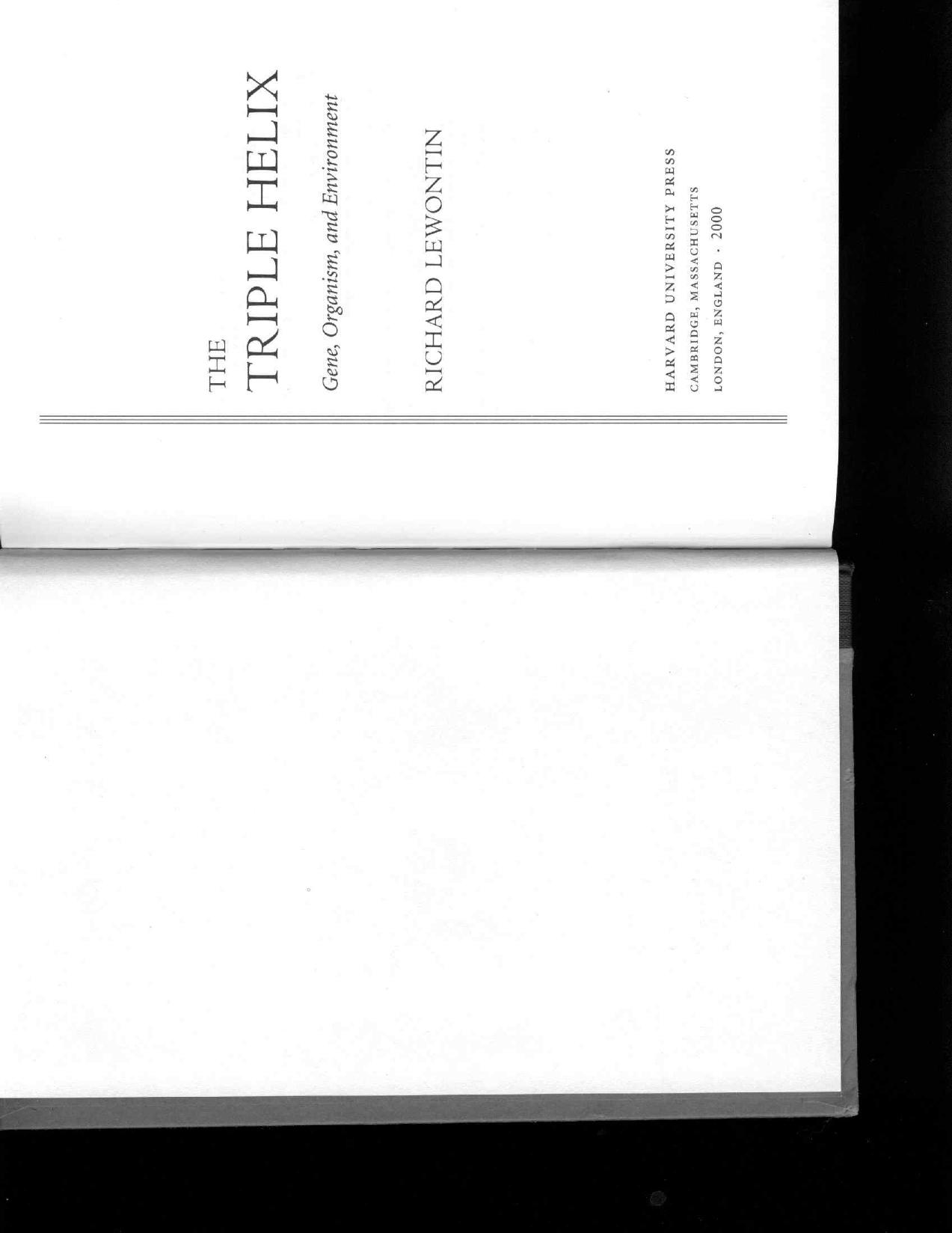The Triple Helix: Gene, Organism, and Environment by Richard Lewontin

Author:Richard Lewontin
Language: eng
Format: mobi, pdf
Publisher: Harvard University Press
Published: 0101-01-01T00:00:00+00:00
III
PARTS AND WHOLES,
CAUSES
AND EFFECTS
The previous two chapters dealt with two aspects of a common theme. How is the natural world of objects and processes to be broken up in such a way as to provide a proper understanding of the history and operation of natural phenomena? The problem of how to parse the world into appropriate bits and pieces is a consequence of the analytic tradition that modern science has inherited from the seventeenth century. If the animal is like a machine, as Descartes claimed in Part V of the Discourse on Method, then it is made up of clearly distinguishable bits and pieces, each of which has a determined causal relation to the movement of other bits and pieces.
But Descartes's machine model is not only a description of how the world operates but also a manifesto for how to study natural phenomena. If I wish to study an animal as a machine, I commit myself to behaving as if the animal can be broken down into pieces whose identity as pieces is unproblematic and which have a clear chain of causal connections with each other in producing the properties of the whole. If, wishing to study the operations of a mechanical clock, I open it, I will see a collection of gears, levers, and springs whose status as the parts of the clock are never in doubt. There is no question about where one gear starts and another ends, nor that these immediately perceived separate pieces are the elements whose functional relations need to be specified in any explanation of the operations of the clock as a whole. Furthermore, by removing, altering, or interfering with the operation of each gear and lever separately, I can analyze the chain of forces driving and regulating the clock. The entire explanation will be framed in terms of how the spring transmits a motive force to one gear which transmits forces to a second gear and so on to a third, all at rates determined by the number of teeth in each gear and limited by the escapement mechanism. There is a clear chain of causes and effects among the predefined physical elements of the machine.
Such an analytic mode of understanding and study of biological systems, appropriate to a machine, is implied in the very word organism, first used in the eighteenth century. The analogy is between the living body and the musical instrument composed of separate parts that work together to produce a variety of final functions. This was a radical departure from the holistic pre-Enlightenment view of natural systems as indissoluble wholes that could not be understood by being taken apart into bits and pieces, a view echoed in Alexander Pope's simile:
Like following life thro' creatures you dissect, You lose it in the moment you detect.
Over the last three hundred years the analytic model has been immensely successful in explaining nature in such a way as to allow us to manipulate and predict it. It seems abundantly clear to us now
Download
The Triple Helix: Gene, Organism, and Environment by Richard Lewontin.pdf
This site does not store any files on its server. We only index and link to content provided by other sites. Please contact the content providers to delete copyright contents if any and email us, we'll remove relevant links or contents immediately.
| Cell Biology | Developmental Biology |
| Entomology | Marine Biology |
| Microbiology | Molecular Biology |
| Biostatistics |
Sapiens: A Brief History of Humankind by Yuval Noah Harari(13053)
The Tidewater Tales by John Barth(12030)
Do No Harm Stories of Life, Death and Brain Surgery by Henry Marsh(6336)
Mastermind: How to Think Like Sherlock Holmes by Maria Konnikova(6236)
The Thirst by Nesbo Jo(5785)
Why We Sleep: Unlocking the Power of Sleep and Dreams by Matthew Walker(5642)
Sapiens by Yuval Noah Harari(4537)
Life 3.0: Being Human in the Age of Artificial Intelligence by Tegmark Max(4507)
The Longevity Diet by Valter Longo(4445)
The Rules Do Not Apply by Ariel Levy(3906)
The Immortal Life of Henrietta Lacks by Rebecca Skloot(3826)
The Body: A Guide for Occupants by Bill Bryson(3802)
Why We Sleep by Matthew Walker(3773)
Animal Frequency by Melissa Alvarez(3755)
Yoga Anatomy by Kaminoff Leslie(3701)
Barron's AP Biology by Goldberg M.S. Deborah T(3632)
The Hacking of the American Mind by Robert H. Lustig(3580)
All Creatures Great and Small by James Herriot(3516)
Yoga Anatomy by Leslie Kaminoff & Amy Matthews(3396)
